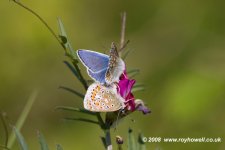David Smith
Warrington Lancs
Having got myself a nice (180mm) macro lense I am enjoying that.
However!!
I wonder if extension rings on my 100-400 would give a further dimension i.e. butterflies'dragonflies etc won't stay still however many times I ask them
So a few questions please:-
a) If I add extension ring/rings will it enable me to shoot butterlies from
further away e.g. 2-3 metres?
b) Will depth of field make it just as difficult as with standard macro?
c) Do Kenko rings enable full auto functions?
d) Do you lose mutch quality ?
etc. etc.
I'm not thinking of using them instead of-just wonder if they are a useful add-on?
However!!
I wonder if extension rings on my 100-400 would give a further dimension i.e. butterflies'dragonflies etc won't stay still however many times I ask them
So a few questions please:-
a) If I add extension ring/rings will it enable me to shoot butterlies from
further away e.g. 2-3 metres?
b) Will depth of field make it just as difficult as with standard macro?
c) Do Kenko rings enable full auto functions?
d) Do you lose mutch quality ?
etc. etc.
I'm not thinking of using them instead of-just wonder if they are a useful add-on?




